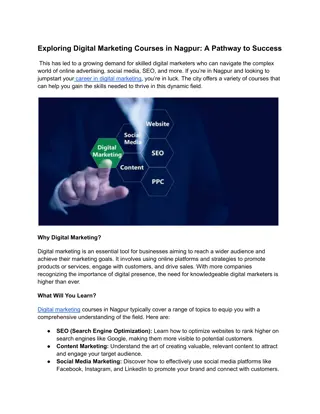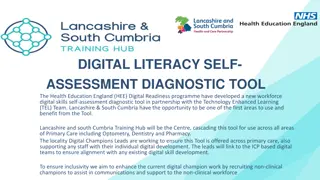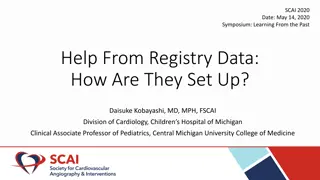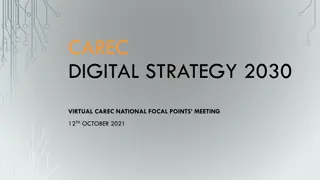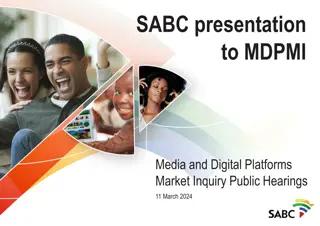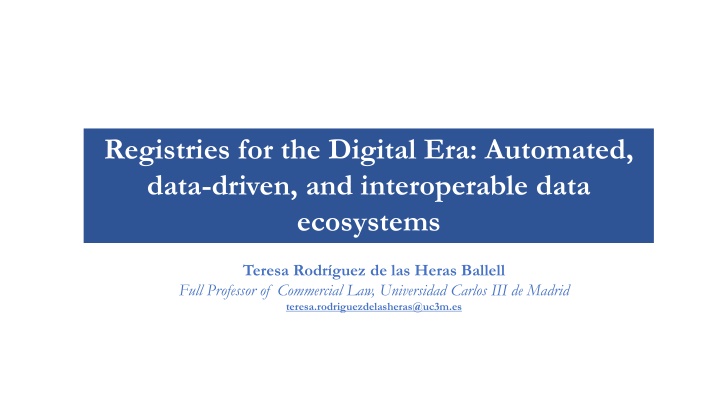
Automated Data Registries for Interoperable Digital Ecosystems
Explore the complexities of automated data registries in the digital era, focusing on interoperability, legal implications, effectiveness against third parties, and recommendations for transactions. Learn about the key findings and the role of technology in shaping the future of registries.
Download Presentation

Please find below an Image/Link to download the presentation.
The content on the website is provided AS IS for your information and personal use only. It may not be sold, licensed, or shared on other websites without obtaining consent from the author. If you encounter any issues during the download, it is possible that the publisher has removed the file from their server.
You are allowed to download the files provided on this website for personal or commercial use, subject to the condition that they are used lawfully. All files are the property of their respective owners.
The content on the website is provided AS IS for your information and personal use only. It may not be sold, licensed, or shared on other websites without obtaining consent from the author.
E N D
Presentation Transcript
Registries for the Digital Era: Automated, data-driven, and interoperable data ecosystems Teresa Rodr guez de las Heras Ballell Full Professor of Commercial Law, Universidad Carlos III de Madrid teresa.rodriguezdelasheras@uc3m.es
Hypothesis Technology Technology Other Role of Registries Implementation functionalities New roles / new functions Legal implications
Initial findings Technology-neutrality approach MLST I.- Multiplicity of registries Data-driven - Sectoral / general - Local / domestic / international - Purposes - Organization Interoperable II.- Characterization and effectiveness method Automated III.- Limited visibility effect / fossilization
Effectiveness against third-parties: Data-driven registers v. control 1. Push models Signalling Oracles Dynamic Granular Visible Control Trading platforms
Interoperable registries: data ecosystem 2. Data reliability expectations Liability Ex officio - upon request
Recommendation Transactions: 56 of the UNCITRAL Legislative Guide on Secured The law should provide for the allocation of responsibility for loss or damage caused by an error in the administration or operation of the registration and searching system. If the system is designed to permit direct registration and searching by registry users without the intervention of registry personnel, the responsibility of the registry for loss or damage should be limited to system malfunction Article 32 LMST - Limitation of liability of the Registry Three options Article 28(1) CTC: The Registrar shall be liable for compensatory damages for loss suffered by a person directly resulting from an error or omission of the Registrar and its officers and employees or from a malfunction of the international registration system except where the malfunction is caused by an event of an inevitable and irresistible nature, which could not be prevented by using the best practices in current use in the field of electronic registry design and operation, including those related to back-up and systems security and networking.
ELI Guiding Principles on Automated Decision-Making Model Law on Automated Contracting July 2024 Legal recognition rules UNCITRAL WG IV on E-Commerce Use of AI in international trade Decision and action attribution rules Contracts in machine code and with dynamic information Error rules Treatment of unexpected or unforeseen action
Article 4. Technology neutrality Nothing in this Law requires the use of an automated system or a particular method in automated systems to form or perform contracts. Article 5. Legal recognition of automated contracting 1. A contract formed using an automated system shall not be denied validity or enforceability on the sole ground that no natural person reviewed or intervened in any action carried out in connection with the formation of the contract. 2. An action carried out by an automated system in connection with the formation or performance of a contract shall not be denied legal effect, validity or enforceability on the sole ground that no natural person reviewed or intervened in the action.
Article 6. Legal recognition of contracts in computer code and use of dynamic information in automated contracting 1. A contract shall not be denied validity or enforceability on the sole ground that the terms of the contract are contained in data messages in the form of computer code. 2. A contract shall not be denied validity or enforceability on the sole ground that the terms of the contract incorporate information from a data source that provides information that changes periodically or continuously. 3. An action in connection with the formation of a contract shall not be denied legal effect, validity or enforceability on the sole ground that the action involves processing data messages containing information from a source that provides information that changes periodically or continuously.
I.- Technology impacts on the role of registries II.- Technology impacts on risk allocation III.- Technology-neutrality: Electronic registers are, nonetheless, designed and operate as traditional registers IV.- Data-driven registry system focuses on data accessibility (signaling effect) V.- Liability rules should be adapted to core functions VI.- Automation may enhance effectiveness of traditional registers.
Teresa Rodrguez de las Heras Ballell Full Professor of Commercial Law, Universidad Carlos III de Madrid teresa.rodriguezdelasheras@uc3m.es










